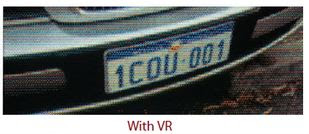Virtual Resolution (VR), Pixel sharing, Enhanced Pixel Performance, whatever you want to call it, the technology has been around for more than a decade, but has only recently begun to truly shine with regard to performance.
A Pixel is a grouping of LEDs (1 red, 1 green, 1 blue aka 1R1G1B, sometimes 2R1G1B). A pixel pitch is the measurement from one center point of a pixel to the next center point. The tighter the pitch, the closer the pixels and the higher the resolution of the display. As you can see from the images, virtual pixel technology improves the resolution of letters and images.
20mm Non‐Virtual 20mm - 10mm Virtualized
Virtual Resolution (VR)


Virtual Resolution: LED pixels are able to share LEDs between them, thus halving the distance from one pixel to another and virtually doubling the resolution of the display (ex: If you have a 20mm display with a 48 x 96 matrix, its virtual resolution would be double at 96 x 192). This results in smoother graphics (less blocking) and extremely dynamic and fluid video.
This improvement is achieved by sharing individual LEDs between pixels. While a “regular” pixel only has single red, blue and green LEDs available, a virtual board can use blended LEDs from any other nearby pixel thus making a sharper, cleaner image. With any technology which is hard to reproduce, there are the nay-sayers and rumor-mongers.
A few of the biggest myths out there regarding virtual resolution:
- The technology overdrives LEDs and causes them to burn out faster.
- LED Signs using VR has blurry text and static images don’t look clear.
- VR puts a strain on the system causing the controller to fail prematurely.
- VR makes a 20mm sign look exactly like a 10mm sign.
There is a small amount of truth in the best of lies and it's important (as always) to pay attention to the details. In brief:
1. LED Early Burnout Some unscrupulous manufacturers overdrive their LEDs to make them brighter. Unfortunately these same manufacturers also utilize VR technology. The overdriving of LEDs has nothing to do with VR. Overdriving LEDs is a poor choice for a short-game sale which causes a display’s LEDs to depreciate faster and the sign to lose performance over time; a sign which should have been good for five to ten years is only good for two or three (at best). Because the two were coming hand-in-hand when the technology first was in use, people still associate VR systems with overdriving.
2. Poor Resolution
Take a look at the picture above, if anything the e is vastly improved and not “fuzzy" at all. The same is true with images. VR helps tremendously with animated content (especially video). Video runs at 25 frames per second and often has a slight "blur" with heavy motion. Real Pixel displays often have issues replicating the blur where a VR display can smoothly duplicate the effect. Some people mistakenly associate the "blur" explanation with VR overall and thus the fuzzy understanding.
3. System Strain
VR technology simply shares LEDs. The way it shares each LED is complex but doesn’t burden a controller with any additional computing power which it isn’t already pushing to the sign. Most of the “work” is done in the chipsets themselves and how the chips are “addressed” in a system.
4. I can't believe it's not a real pixel
A lot of salespeople will tell you a 20mm virtual looks just like a 10mm real. This simply isn’t true. The real thing will always be better. A 20mm virtual will make the display look crisper, more defined with sharper images and smoother lines. It’s an upgrade on the system which makes it stand out from the competition and usually the upgrade comes at a lower cost than buying a tighter pixel pitch (great for end-users who just can’t afford the next step up).
Virtual Resolution technology is here to stay and with the vast improvements in the technology, it’s just going to keep getting better. It’s a cost efficient option to improve sign definition for end-users and should definitely be an option carried by your manufacturer. If the manufacturer you’re looking at doesn’t offer VR, ask them what other technologies they aren't offering/integrating. Make sure they're giving you the best system options possible. Don't make the very real mistake of overlooking the virtual option for your LED sign.
*Always feel free to comment here and/or email me directly with requests at deacon@vantageled.com. Vantage LED has white paper resources and more educational material on the website (http://www.vantageled.com), please check it out when you have a moment.
**Note all posts/thoughts/writings are strictly the viewpoint of me and me alone and do not reflect nor speak for Vantage LED’s beliefs, attitudes, thoughts, etc. unless specifically stated.

No comments:
Post a Comment